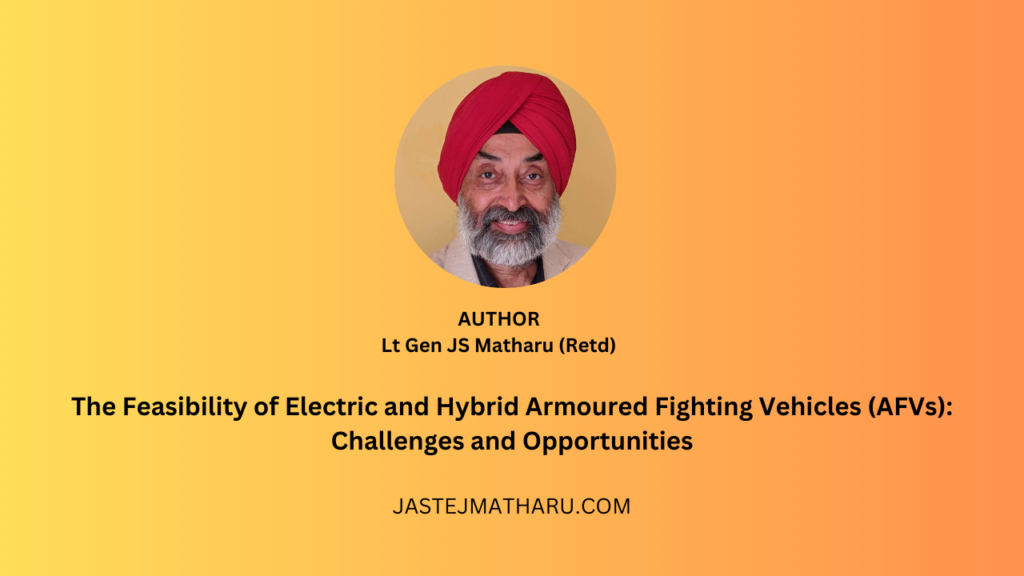
Let us examine the possibility of having an electric Armoured Fighting Vehicle (AFV).
Electric components have always been a challenge in the design of AFVs. For example In the case of tanks a large number of services which are utilised need electrical power. A tank uses electricity for radio and intercommunication, for the wipers, for the various types of night vision devices, for the computer systems, for the automotive auxiliaries like the various types of pumps, the gauges, the navigation equipment, lighting systems, ventilation systems, gun control system and the fire control system.
To cater for these electrical loads, like any other vehicle the tank also has batteries that are charged by using the power from the main engine. Some tanks have an auxiliary engine for charging the batteries thus conserving the life of the main engine. Also the auxiliary engine operates at a much lower level of noise than the main engine.
In a tactical situation a tank often needs to function in silent watch mode. During this time the tank uses the power stored in its batteries. It follows that we need to have batteries with sufficient capacity to allow functioning of the tank in such a mode.
The heaviest drain on the batteries is during starting. To get around this problem certain tanks have an air starting system, in which air bottles are charged by a compressor getting drive from the main engine and this pressurised air is used for starting the engine.
So in a tank, say which is in the 40 tons to 50 tons range, you will have a 1000 bhp plus engine, which will be the largest component of the vehicle and occupy considerable space in the engine compartment.
If we were to replace the engine with an electric motor, we would need a very large battery to power this motor.
This will be a major problem because the envelope of the tank has to be kept very tight. An increase in the volume of a tank makes it heavier as additional armour protection becomes necessary. The weight penalty would become unacceptably high. An electric powered tank will have to wait, therefore, for the design of very high energy density batteries, much more powerful than the present day lithium ion batteries.
However, as lithium ion batteries have higher energy density than lead acid batteries, we could replace the existing lead acid batteries of tanks with lithium ion batteries. This will increase the time for which the tank can operate in silent watch with its main engine turned off and thus operate with no noise and a much smaller heat signature. This can be of advantage in a tactical situation. To that extent there is a case for increasing the battery capacity of tanks by replacing the present day lead acid batteries with lithium ion batteries.
It follows that being able to design high energy density lithium ion batteries will help in designing a better tank.
Moving away from tanks let’s go on to a lighter AFV, say we look at the Armoured Personnel Carrier (APC) or the Infantry Combat Vehicle (ICV). An ICV often needs to be amphibious and may have a tracked or wheeled configuration. In this case, because the vehicle is lighter than a tank, therefore it becomes more conducive to the possibility of being powered electrically.
A purely electric vehicle would need a fairly large battery, and there is another aspect which will come in, and that is that normally when we are operating in a battle area, the availability of electricity is unlikely. Therefore, while you may be able to have a fully electric ICV in a peacekeeping role or a policing role, it may not be a viable option in the case of a battle area even though it may be feasible to design such a vehicle.
However, a hybrid ICV may become a possibility. In such a vehicle the balance between the capacities of the internal combustion engine and the electric motor will have to be decided with a lot of care.
In a purely electric vehicle the logistics of transporting fuel to it will disappear. In a hybrid vehicle the fuel consumption will reduce and refueling logistics will ease out somewhat.
Where the electric vehicle has a clear advantage over the internal combustion vehicle is that the torque curve of the electric vehicle is the best possible torque curve. It provides very high torque at slow speeds thus making the electric ICV very agile from rest and at slow speed. This is an advantage in a tactical situation. The electric ICV will not need gears and the driver could make it accelerate quickly just by pressing the accelerator pedal.
Another advantage which an electric ICV will have over the internal combustion engine ICV is the ability to move silently. This will be a big advantage in a tactical situation. Therefore the hybrid ICV again seems to suggest itself as a possible option.
In a tracked ICV an internal combustion engine drives the tracks through a driveline and sprockets. However, in a wheeled ICV each wheel has to be given drive. This means that you have the engine at one end of the vehicle, usually the front end, and you have to transmit this drive mechanically to all the wheels through a system of drive shafts and differentials and you need to provide for differential locks and inter axle locks so that the vehicle is able to pull itself out of a difficult position. This adds a large amount of weight to the overall weight of the vehicle.
On the other hand, in the case of an electrical vehicle while the battery will be large and will have considerable weight but the drive to the wheels will be much lighter as compared to the mechanical drive needed in an internal combustion engine, as each wheel will have its own electric motor.
These motors can be very easily utilized through a computer which can be designed to control the motion of these motors. This will allow the driver to engage different drive configurations. Let us take a six wheeled vehicle and say that two wheels are slipping due to inadequate surface grip, you just cut the drive to the motors driving these wheels and extricate the stuck vehicle by giving drive to the remaining four wheels which are not slipping. This will be a very powerful advantage of having an electrical vehicle.
The next thing which comes is that ICVs need to be amphibious, over here we need to ensure that the electric motors are totally sealed and kept free from any possible water ingress.
Also an amphibious vehicle has to propel itself in water. This may be done by the wheels, or propellers or water jets. Traditionally such drives have been difficult to achieve, as these were mechanical drives. On the other hand it will be easy to give an electric drive to a propeller through an appropriately placed drive motor. The designer of an electrical vehicle will have much more flexibility as compared to the designer of an internal combustion engine vehicle. An electrical ICV will be equally agile on land and on water.
In any AFV whether a tank or an ICV there is a need for having a minimum speed which is needed to operate in a tactical environment. Also there will be a need to have adequate top speed on both roads and cross country. Here also the electric powered vehicle will be better as the electric motor gives excellent torque at slower speeds without any need of changing gears.
For vehicles which are even lighter than ICVs like armoured reconnaissance vehicles the hybrid vehicle may become a viable option.
Storing liquid fuels in AFVs has always been a challenge as this gives rise to a fire hazard problem. Any reduction in fuel storage requirements will reduce this hazard. Thus there is an advantage of having electric or hybrid vehicles.
Maintenance requirements of electric vehicles are typically less than internal combustion engines.
Internal combustion engines are vulnerable to quick wear and tear in deserts as dust may be ingested. To prevent this air cleaning systems have to be designed and maintained with perfection. Electrical vehicles will have no such problem.
Broadly speaking as far as design is concerned; in a tank you would have a more powerful electrical system with lithium ion batteries, which will give a tank a greater ability to operate silently. In ICVs you may have hybrid vehicles which will be very agile both on water and land, and in the case of the lighter reconnaissance armoured vehicles you may be able to have vehicles which may be fully electric or hybrid vehicles. Hybrid vehicles have higher ranges of operation with the same amount of fuel thus easing the logistical load of supplying fuel.
Storing and transporting fuel is a major challenge in any operation and any easing of this load will free resources for other logistic tasks. Though conversely spare battery packs will have to be provisioned for the electric and hybrid vehicles. However, if we were to use a standardised battery pack in all vehicles it would also lead to helping out with other battery powered equipment which we already have in a battle area.
Finally it appears that with the technology available in the civilian electric vehicle industry, such as better batteries and motors, it looks that the day is not far when we will see vehicles which have large capacity batteries or full fledged electric or hybrid armoured fighting vehicles in the battlefield milieu.
